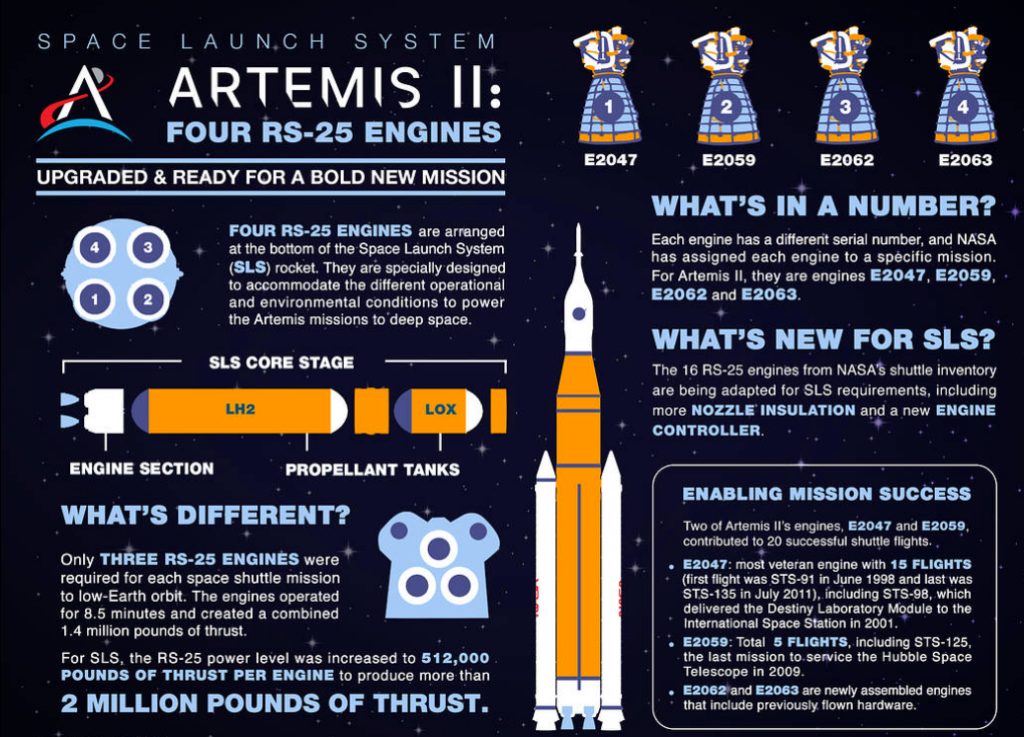Artemis II images
Artemis II: Core Stage and RS-25
Artemis II : Heat shield
Artemis II: Orion Crew Model (CM)
Artemis missions
With Artemis missions, NASA will land the first woman and first person of color on the Moon, using innovative technologies to explore more of the lunar surface than ever before. We will collaborate with commercial and international partners and establish the first long-term presence on the Moon. Then, we will use what we learn on and around the Moon to take the next giant leap: sending the first astronauts to Mars.
Artemis Base Camp on the surface and a Gateway in lunar orbit. These elements will allow robots and astronauts to explore.
Who was Artemis?
In ancient Greek religion and mythology, Artemis (/ˈɑːrtɪmɪs/; Greek: Ἄρτεμις) is the goddess of the hunt, the wilderness, wild animals, nature, vegetation, childbirth, care of children, and chastity. In later times, in some places, she was identified with Selene, the personification of the Moon. She often roamed the forests of Greece, attended by her large entourage, mostly made up of nymphs, some mortals, and hunters. The goddess Diana is her Roman equivalent.
In Greek tradition, Artemis is the daughter of Zeus and Leto, and the twin sister of Apollo. In most accounts, the twins are the products of an extramarital liaison. For this, Zeus’ wife Hera forbade Leto from giving birth anywhere on land. Only the island of Delos gave refuge to Leto, allowing her to give birth to her children. Usually, Artemis is the twin to be born first, who then proceeds to assist Leto in the birth of the second child, Apollo. Like her brother, she was a kourotrophic (child-nurturing) deity, that is the patron and protector of young children, especially young girls, and women, and was believed to both bring disease upon women and children and relieve them of it. Artemis was worshipped as one of the primary goddesses of childbirth and midwifery along with Eileithyia and Hera. Much like Athena and Hestia, Artemis preferred to remain a maiden goddess and was sworn never to marry, so was one of the three Greek virgin goddesses, over whom the goddess of love and lust, Aphrodite, had no power whatsoever.
In myth and literature, Artemis is presented as a hunting goddess of the woods, surrounded by her followers, who are not to be crossed. In the myth of Actaeon, when the young hunter sees her bathing naked, he is transformed into a deer by the angered goddess and is then devoured by his own hunting dogs, who do not recognize their master. In the story of Callisto, the girl is driven away from Artemis’ company after breaking her vow of virginity, having lain with and been impregnated by Zeus.
In the Epic tradition, Artemis halted the winds blowing the Greek ships during the Trojan War, stranding the Greek fleet in Aulis, after King Agamemnon, the leader of the expedition, shot and killed her sacred deer. Artemis demanded the sacrifice of Iphigenia, Agamemnon’s young daughter, as compensation for her slain deer. In most versions, when Iphigenia is led to the altar to be offered as a sacrifice, Artemis pities her and takes her away, leaving another deer in her place. In the war that followed, Artemis, along with her twin brother and mother, supported the Trojans against the Greeks, and challenged Hera into battle.
Artemis was one of the most widely venerated of the Ancient Greek deities; her worship spread throughout ancient Greece, with her multiple temples, altars, shrines, and local veneration found everywhere in the ancient world. Her great temple at Ephesus was one of the Seven Wonders of the Ancient World, before it was burnt to the ground. Artemis’ symbols included a bow and arrow, a quiver, and hunting knives, and the deer and the cypress were sacred to her. Diana, her Roman equivalent, was especially worshipped on the Aventine Hill in Rome, near Lake Nemi in the Alban Hills, and in Campania.
Footnote
- Sources: Aerospace dashboard, funkystuff.org
- Outgoing: NASA
- Keywords: Artemis II images





